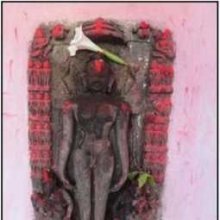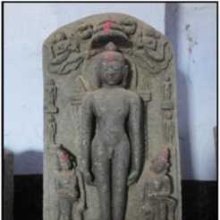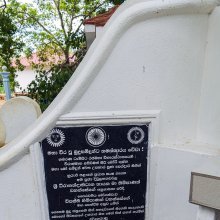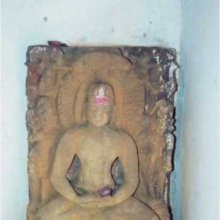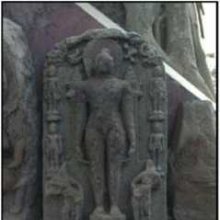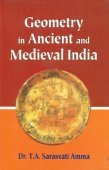Mahavira, Mahāvīra, Maha-vira: 31 definitions
Introduction:
Mahavira means something in Buddhism, Pali, Hinduism, Sanskrit, Jainism, Prakrit, the history of ancient India, Hindi. If you want to know the exact meaning, history, etymology or English translation of this term then check out the descriptions on this page. Add your comment or reference to a book if you want to contribute to this summary article.
Alternative spellings of this word include Mahavir.
Images (photo gallery)
(+20 more images available)
In Hinduism
Purana and Itihasa (epic history)
Source: archive.org: Puranic Encyclopedia1) Mahāvīra (महावीर).—A son of Priyavrata. Svāyambhuva Manu had two famous sons named Priyavrata and Uttānapāda. Of them, Priyavrata married Surūpā and Barhiṣmatī, the two beautiful and virtuous daughters of Viśvakarma Prajāpati. By his first wife Surūpā, Priyavrata had ten sons, namely, Agnīdhra, Idhmajihva, Yajñabāhu, Mahāvīra, Rukmaśukra, Ghṛtapṛṣṭha, Savana, Medhātithi, Vītihotra and Kavi. The youngest of his children was a daughter named Ūrjjasvatī. (Devī Bhāgavata, 8th Skandha).
2) Mahāvīra (महावीर).—Mahābhārata, Ādi Parva, Chapter 67, Verse 68, refers to a Mahāvīra, who was the re-birth of the Asura Krodhavaśa.
Source: archive.org: Shiva Purana - English TranslationMahāvīra (महावीर) refers to “one who is heroic” and is used to describe Tāraka-Asura, according to the Śivapurāṇa 2.3.15 (“The penance and reign of Tārakāsura”).—Accordingly, as Brahmā narrated: “That Varāṅgī, when the time was complete, delivered of a son of huge body and great strength dazzling the ten quarters. [...] Then Kaśyapa Prajāpati thought well and named the powerful demon Tāraka. That heroic [i.e., mahāvīra] demon, with his manliness and valour manifesting quickly grew and developed with his steely frame like the lord of mountains. Then the demon Tāraka, of great strength and exploit, endowed with a lofty mind, requested permission of his mother for performing penance. [...]”.
Source: Cologne Digital Sanskrit Dictionaries: The Purana IndexMahāvīra (महावीर).—A son of Priyavrata, remained a bachelor all through life engaged in ātmavidyā.*
- * Bhāgavata-purāṇa V. 1. 25-6.
Mahāvīra (महावीर) is a name mentioned in the Mahābhārata (cf. I.61.55) and represents one of the many proper names used for people and places. Note: The Mahābhārata (mentioning Mahāvīra) is a Sanskrit epic poem consisting of 100,000 ślokas (metrical verses) and is over 2000 years old.

The Purana (पुराण, purāṇas) refers to Sanskrit literature preserving ancient India’s vast cultural history, including historical legends, religious ceremonies, various arts and sciences. The eighteen mahapuranas total over 400,000 shlokas (metrical couplets) and date to at least several centuries BCE.
Kavya (poetry)
Source: OpenEdition books: Vividhatīrthakalpaḥ (Kāvya)Mahāvīra (महावीर) or simply Vīra is mentioned in the Vividhatīrthakalpa by Jinaprabhasūri (13th century A.D.): an ancient text devoted to various Jaina holy places (tīrthas).—Accordingly, “Mahāvīra spends the third year in Campa; Mahāvīra spends the fourth year in Piṭṭhīcampā; Between the ninth and the tenth year, the Nāga Sudāḍha torments Mahāvīra; Mahāvīra passes the tenth loved one to Śrāvastī; Mahāvīra spends the eleventh year in Mithilā; Between the eleventh and the twelfth year, Candanā breaks the fast of Mahāvīra in Kauśāmbī; Mahāvīra spends the twelfth year in Campā; Mahāvīra holds a plenary assembly in Kauśāmbī: the Sun and the Moon descend to pay homage to him; [...]”.

Kavya (काव्य, kavya) refers to Sanskrit poetry, a popular ancient Indian tradition of literature. There have been many Sanskrit poets over the ages, hailing from ancient India and beyond. This topic includes mahakavya, or ‘epic poetry’ and natya, or ‘dramatic poetry’.
Ayurveda (science of life)
Veterinary Medicine (The study and treatment of Animals)
Source: Shodhganga: Portrayal of Animal Kingdom (Tiryaks) in Epics An Analytical study1) Mahāvīra (महावीर) (lit. “one who is a great hero”) is a synonym (another name) for the Lion (Siṃha), according to scientific texts such as the Mṛgapakṣiśāstra (Mriga-pakshi-shastra) or “the ancient Indian science of animals and birds” by Hamsadeva, containing the varieties and descriptions of the animals and birds seen in the Sanskrit Epics such as the Ramayana and Mahabharata.
2) Mahāvīra (महावीर) (lit. “one who is a great warrior”) is also another name for Garuḍa.

Āyurveda (आयुर्वेद, ayurveda) is a branch of Indian science dealing with medicine, herbalism, taxology, anatomy, surgery, alchemy and related topics. Traditional practice of Āyurveda in ancient India dates back to at least the first millenium BC. Literature is commonly written in Sanskrit using various poetic metres.
Shaktism (Shakta philosophy)
Source: Google Books: ManthanabhairavatantramMahāvīra (महावीर) refers to “great heroes” (devoted to worship and meditation), according to the Kulapañcāśikā, an unpublished text attributed to Matsyendranātha teaching secrecy.—Accordingly, “O Hara, why is it that those people who are great heroes [i.e., mahāvīra] devoted to worship and meditation, greedy to drink (the sacrificial) blood—who, well established, carry swords and are devoted, O god, to wandering at night in cremation ground(s)—do not always attain union with the Yoginīs?”.—Note: The Kulapañcāśikā is quoted by Kṣemarāja in his commentary on the Netratantra 8.28 (= Kulapañcāśikā 3.7-8) and on Śivasūtra 3.26 (= Kulapañcāśikā 3.19).

Shakta (शाक्त, śākta) or Shaktism (śāktism) represents a tradition of Hinduism where the Goddess (Devi) is revered and worshipped. Shakta literature includes a range of scriptures, including various Agamas and Tantras, although its roots may be traced back to the Vedas.
Shaivism (Shaiva philosophy)
Source: SOAS University of London: Protective Rites in the Netra TantraMahāvīra (महावीर) refers to a “great hero”, according to the Netratantra of Kṣemarāja: a Śaiva text from the 9th century in which Śiva (Bhairava) teaches Pārvatī topics such as metaphysics, cosmology, and soteriology.—Accordingly, [verse 10.1-7ab, while describing the appearance and worship of Bhairava]—“[...] He] bears a sword and shield, holds a hook and noose. [His] hand[s and posed] in the wish fulfilling and protection [mudrās. He] holds the thunderbolt of a great hero (mahāvīra—vajrahastaṃ mahāvīraṃ). [He also] holds an axe and a hatchet. Having worshipped Bhairava, [the Mantrin] remembers being joined in union [with] him, [in the same way as] dissolution in fire”.

Shaiva (शैव, śaiva) or Shaivism (śaivism) represents a tradition of Hinduism worshiping Shiva as the supreme being. Closely related to Shaktism, Shaiva literature includes a range of scriptures, including Tantras, while the root of this tradition may be traced back to the ancient Vedas.
In Buddhism
Tibetan Buddhism (Vajrayana or tantric Buddhism)
Source: academia.edu: A Critical Study of the Vajraḍākamahātantrarāja (II)Mahāvīra (महावीर) is the husband of Vāyuvegā: the name of a Ḍākinī (‘sacred girl’) presiding over Triśakuni: one of the four Upakṣetra (‘sacred spot’) present within the Vākcakra (‘circle of word’), according to the 9th-centruy Vajraḍākatantra. The Vākcakra is one of three Cakras within the Tricakra system which embodies twenty-four sacred spots or districts resided over by twenty-four Ḍākinīs whose husbands (viz., Mahāvīra) abide in one’s body in the form of twenty-four ingredients (dhātu) of one’s body.
Vāyuvegā has for her husband the hero (vīra) named Mahāvīra. She is the presiding deity of Triśakuni and the associated internal location are the ‘navel’ and the bodily ingredients (dhātu) are the ‘lungs’.
Source: academia.edu: The Structure and Meanings of the Heruka MaṇḍalaMahāvīra (महावीर) is the name of a Vīra (hero) who, together with the Ḍākinī named Vāyuvegā forms one of the 36 pairs situated in the Vajracakra, according to the 10th century Ḍākārṇava chapter 15. Accordingly, the vajracakra refers to one of the four divisions of the sahaja-puṭa (‘innate layer’), situated within the padma (lotus) in the middle of the Herukamaṇḍala. The 36 pairs of Ḍākinīs and Vīras [viz., Mahāvīra] each have one face and four arms; they hold a skull bowl, a skull staff, a small drum and a knife; they are dark-bluish-black in color.
Source: OSU Press: Cakrasamvara Samadhi1) Mahāvīra (महावीर) is the name of a Ḍāka (male consort) and one of the deities of the Cakrasaṃvara-maṇḍala or Saṃvaramaṇḍala of Abhayākaragupta’s Niṣpannayogāvalī, p. 45 and n. 145; (Cf. Cakrasaṃvaratantra, Gray, David B., 2007).—The Cakrasaṃvara mandala has a total of sixty-two deities. [...] Three concentric circles going outward, the body, speech and mind wheels (kāya-vāka-citta), in the order: mind (blue), speech (red), and body (white), with eight Ḍākinīs each in non-dual union with their Ḍākas, "male consorts".
Associated elements of Vāyuvegā and Mahāvīra:
Circle: vākacakra [=vākcakra?] (speech-wheel) (red);
Ḍākinī (female consort): Vāyuvegā;
Ḍāka (male consort): Mahāvīra;
Bīja: triṃ;
Body-part: navel;
Pīṭha: Triśakuni;
Bodily constituent: phupphusa (lungs);
Bodhipakṣa (wings of enlightenment): vīryabala (power of effort).
2) Mahāvīrā (महावीरा) is the name of a Ḍākinī (female consort) coupled with Vajrasattva:
Circle: kāyacakra (body-wheel) (white);
Ḍākinī (female consort): Mahāvīrā;
Ḍāka (male consort): Vajrasattva;
Bīja: kuṃ;
Body-part: knees;
Pīṭha: Kulutā;
Bodily constituent: siṅghāṇaka (snot);
Bodhipakṣa (wings of enlightenment): samyagvāc (right speech).

Tibetan Buddhism includes schools such as Nyingma, Kadampa, Kagyu and Gelug. Their primary canon of literature is divided in two broad categories: The Kangyur, which consists of Buddha’s words, and the Tengyur, which includes commentaries from various sources. Esotericism and tantra techniques (vajrayāna) are collected indepently.
In Jainism
General definition (in Jainism)
Source: Wisdom Library: JainismMahāvīra (महावीर):—The twenty-fourth Tīrthaṅkara (Janism recognizes 24 such teachers or Siddhas). His colour is gold (kāñcana), according to Aparājitapṛcchā (221.5-7). His height is 7 hatha (4 hatha equals 1 dhanuṣa, which equals 6 feet), thus, roughly corresponding to 3.2 meters. His emblem, or symbol, is a Lion.
Mahāvīra’s father is Siddhārtha and his mother is Triśalā according to Śvetāmbara or Priyakāriṇī according to Digambara. It is an ancient Jain practice to worship the Tīrthaṅkara’s parents in various rites, such as the pratiṣṭhāvidhi, according to the Ācāradinakara (14th work on Jain conduct written by Vardhamāna Sūri).
Source: archive.org: The Jaina IconographyMahāvīra (महावीर) refers to the last of twenty-four Tīrthaṃkaras or Jinas, commonly depicted in Jaina iconography.—Mahāvīra, the twenty-fourth or the last Jina is the greatest of all the Tīrthaṃkaras. His position is of unchallenged eminence in the Jaina religion, history and iconography. Being the Lion among the Jaina prophets, rightly given was his emblem of a lion. His Yakṣa spirits are respectively known as Mātaṅga and Siddhāyikā. The Magadhan King Śreṇika or better known as Bimbisāra acts as his Chowri-bearer. His Kevala tree is called Sāla (L. Shorca robusta).
Vardhamāna was born of a royal family of Videha or North Bihār, his father Siddhārtha, being the ruling prince of Kuṇḍapura, the abode of the Nāta or Nāya clan, his mother is known by the name of Triśalā. Connected with his birth is the auspicious legend that the Tīrthaṃkara was actually born of Devanandā of the family of Jālandhara, wife of Ṛṣabha Datta, a Brāhmaṇa, but Indra finding that a Jina ought not to according to tradition, take his birth in a Brahmin family, transferred the foetus through his general Hariṇegameṣa to the womb of Triśala, a Kṣatriya lady of royal family. The child Vardhamāna had shewn early being destined to be a Prophet. Thirty years he lived as a house-holder, but after his parent’s death, he determined to take the ascetic life and obtained the permissionof his brother, who had, then, become king. He renounced everything, all his gold and jewels, distributing them in charity and dividing them among his relatives. He then proceeded in his palanquin to the Park called Sundavana (Śveta) or Sārathi-Khaṇḍa (Digambara in Kuṇḍanagara of Vaiśāli) and there under the Aśoka tree, he stripped himsell of all his raiments and jewels and entered upon an ascetic life of severest penances and austerities.
Source: archive.org: TrisastisalakapurusacaritraMahāvīra (महावीर) or Vīra refers to the last of the twenty-four Tīrthaṅkaras praised in the first book (ādīśvara-caritra) [chapter 1] of Hemacandra’s 11th century Triṣaṣṭiśalākāpuruṣacaritra: an ancient Sanskrit epic poem narrating the history and legends of sixty-three illustrious persons in Jainism.
Mahāvīra is the son of Siddhārtha and Triśalā, according to chapter 1.6, “[...] In Bharata there will be twenty-three other Arhats and eleven other Cakrins. [...] In Kuṇḍagrāma, Mahāvīra, son of Siddhārtha and Triśalā, gold-color, seven cubits tall, with a life of seventy-two years, will be initiated for forty-two years, and the interval between Pārśva and Vīra will be two hundred and fifty years”.
Source: Shodhganga: A cultural study on the jain western Indian illustrated manuscriptsMahāvīra (महावीर).—An illustrated kalpasūtra will open with the image of Mahāvīra recognizable by his symbol of lion below his throne. Mahāvīra sits in padmāsana on a throne supported by lions and elephants facing each other. It is a majestic meditating image resembling sculptural icons.
Source: academia.edu: The epoch of the Mahavira-nirvanaMahāvīra (महावीर), the 24th Tirthankara.—Mahavira was the son of Kundagrama King Siddhartha of Ikshvaku dynasty and Trishala, the sister of King Chetaka of Vajji Ganarajya. According to Guṇabhadra’s Uttarapurāṇa, Mahāvīra became a Siddha in the month of Kārttika, kṛṣṇapakśa-chaturdaśi and Svātinakśatra. Thus, Mahāvīra attained nirvāṇa on 22 nd October 1189-88 BCE, 605 years and 5 months before the commencement of the Śaka era (583 BCE) and 470 years before the commencement of the Kārttikādi Vikrama era (719-718 BCE).
Source: University of Cambridge: JainismMahāvīra (महावीर) refers to one of the 70 teachers mentioned in the Kharataragacchapaṭṭāvalī: a Sanskrit text listing the heads or pontiffs (sūri) of the Kharataragaccha, one of the most important Śvetāmbara monastic orders. The Kharatara-gaccha is especially rooted in Rajasthan. The text includes a narration of events in their lives (i.e., of Mahāvīra), and can thus be called a Kharataragacchapaṭṭāvalī
Source: The University of Sydney: A study of the Twelve ReflectionsMahāvīra (महावीर) refers to “great heroes”, according to the 11th century Jñānārṇava, a treatise on Jain Yoga in roughly 2200 Sanskrit verses composed by Śubhacandra.—Accordingly, “[com.—Next he speaks about the destruction done by Yama (kālakṛtāpāyam) even of great heroes (mahāvīrāṇām)]—This world totters to the limit of the world of Brahmā with the fear of the beginning of a frown, and mountains immediately fall asunder by force of [the fact that] the earth is overcome by the weight of the heavy feet, of those heroes who are all led to death by the king of time in [the space of] some days. Nevertheless, desire is intense only in a living being who is bereft of sense”.
Source: academia.edu: Tessitori Collection IMahāvīra (महावीर) or Mahābīra-gīta refers to one of the twenty-four songs (gīta) embedded in the Caturviṃśatijinagīta by Jinarāja (dealing with classical hymns and stotras from Jain literature), which is included in the collection of manuscripts at the ‘Vincenzo Joppi’ library, collected by Luigi Pio Tessitori during his visit to Rajasthan between 1914 and 1919.

Jainism is an Indian religion of Dharma whose doctrine revolves around harmlessness (ahimsa) towards every living being. The two major branches (Digambara and Svetambara) of Jainism stimulate self-control (or, shramana, ‘self-reliance’) and spiritual development through a path of peace for the soul to progess to the ultimate goal.
India history and geography
Source: Singhi Jain Series: Ratnaprabha-suri’s Kuvalayamala-katha (history)Mahāvīrā (महावीरा) was included in the Rājasabhā, as mentioned by Uddyotanasūri in his 8th-century Kuvalayamālā (a Prakrit Campū, similar to Kāvya poetry).—The Kuvalayamala (779 A.D.) is full of cultural material which gains in value because of the firm date of its composition. [...] On page 14. § 34, a graphic account is given of Rājasabhā which included Maṃtiṇo, Mahāṇariṃdā, Mahāvīrā, Mahāvejjā, Mahābaṃbhaṇā, Mahākaiṇo, Mahāṣeṇāvaiṇo, Mahāpurohiyā, Vāravilāsiṇīo and authorities on different subjects of learning of which the list is given.

The history of India traces the identification of countries, villages, towns and other regions of India, as well as mythology, zoology, royal dynasties, rulers, tribes, local festivities and traditions and regional languages. Ancient India enjoyed religious freedom and encourages the path of Dharma, a concept common to Buddhism, Hinduism, and Jainism.
Languages of India and abroad
Pali-English dictionary
Source: BuddhaSasana: Concise Pali-English Dictionarymahāvīra : (m.) great hero.

Pali is the language of the Tipiṭaka, which is the sacred canon of Theravāda Buddhism and contains much of the Buddha’s speech. Closeley related to Sanskrit, both languages are used interchangeably between religions.
Sanskrit dictionary
Source: DDSA: The practical Sanskrit-English dictionaryMahāvīra (महावीर).—
1) a great hero or warrior.
2) a lion.
3) the thunderbolt of Indra.
4) an epithet of Viṣṇu.
5) of Garuḍa.
6) of Hanumat.
7) a cuckoo.
8) a white horse.
9) a sacrificial fire.
1) a sacrificial vessel.
11) a kind of hawk. °चरितम् (caritam) Name of a celebrated drama by Bhavabhūti.
Derivable forms: mahāvīraḥ (महावीरः).
Mahāvīra is a Sanskrit compound consisting of the terms mahā and vīra (वीर).
Source: Cologne Digital Sanskrit Dictionaries: Shabda-Sagara Sanskrit-English DictionaryMahāvīra (महावीर).—m.
(-raḥ) 1. Garuda the bird, and vehicle of Vishnu. 2. A hero. 3. A lion. 4. A white horse. 5. Sacrificial fire. 6. Indra'S thunderbolt. 7. A bird, a sort of hawk. 8. The Kokila or Indian cuckoo. 9. The last and most celebrated Jina or Jaina teacher of the present who age, is supposed to have flourished in the province of Behar, in the sixth century before the Christian era. 10. Sacrificial vessel. 11. Vishnu. 12. Agni or fire. f.
(-rā) A sort of drug, commonly Kshirakakoli, and conceived to be the dried root of a species of lily. E. mahā great, and bīra hero.
Source: Cologne Digital Sanskrit Dictionaries: Benfey Sanskrit-English DictionaryMahāvīra (महावीर).—m. 1. a hero. 2. a lion. 3. a white horse. 4. a sort of hawk. 5. Garuḍa. 6. Indra's thunderbolt. 7. Viṣṇu. 8. Agni. 9. sacrificial fire.
Mahāvīra is a Sanskrit compound consisting of the terms mahā and vīra (वीर).
Source: Cologne Digital Sanskrit Dictionaries: Cappeller Sanskrit-English DictionaryMahāvīra (महावीर).—[masculine] great hero, [Epithet] of Viṣṇu.
Source: Cologne Digital Sanskrit Dictionaries: Monier-Williams Sanskrit-English Dictionary1) Mahāvīra (महावीर):—[=mahā-vīra] [from mahā > mah] m. a gr° hero, [Ṛg-veda; Kathāsaritsāgara; Tantrasāra]
2) [v.s. ...] Name of Viṣṇu, [Dhyānabindu-upaniṣad]
3) [v.s. ...] an archer, bowman, [cf. Lexicographers, esp. such as amarasiṃha, halāyudha, hemacandra, etc.]
4) [v.s. ...] a lion, [cf. Lexicographers, esp. such as amarasiṃha, halāyudha, hemacandra, etc.]
5) [v.s. ...] Name of Garuḍa (the bird and vehicle of Viṣṇu), [cf. Lexicographers, esp. such as amarasiṃha, halāyudha, hemacandra, etc.]
6) [v.s. ...] of Hanumat, [Apte’s The Practical Sanskrit-English Dictionary]
7) [v.s. ...] of Gautama Buddha, [Monier-Williams’ Buddhism 23]
8) [v.s. ...] sacrificial fire, [Bhāgavata-purāṇa]
9) [v.s. ...] a sacrif° vessel, [Śatapatha-brāhmaṇa]
10) [v.s. ...] thunderbolt, [cf. Lexicographers, esp. such as amarasiṃha, halāyudha, hemacandra, etc.]
11) [v.s. ...] a white horse, [cf. Lexicographers, esp. such as amarasiṃha, halāyudha, hemacandra, etc.]
12) [v.s. ...] the Indian cuckoo, [cf. Lexicographers, esp. such as amarasiṃha, halāyudha, hemacandra, etc.]
13) [v.s. ...] a kind of hawk, [Horace H. Wilson]
14) [v.s. ...] Helminthostachys Laciniata, [cf. Lexicographers, esp. such as amarasiṃha, halāyudha, hemacandra, etc.]
15) [v.s. ...] = jarāṭaka, [cf. Lexicographers, esp. such as amarasiṃha, halāyudha, hemacandra, etc.]
16) [v.s. ...] Name of sub voce kings, [Mahābhārata; Rāmāyaṇa; Purāṇa]
17) [v.s. ...] of the last Arhat of the present Avasarpiṇī (the last and most celebrated Jaina teacher of the present age, supposed to have flourished in Behar in the 6th century B.C.), [Monier-Williams’ Buddhism 529]
18) Mahāvīrā (महावीरा):—[=mahā-vīrā] [from mahā-vīra > mahā > mah] f. a species of bulbous plant, [cf. Lexicographers, esp. such as amarasiṃha, halāyudha, hemacandra, etc.]
Source: Cologne Digital Sanskrit Dictionaries: Yates Sanskrit-English DictionaryMahāvīra (महावीर):—[mahā-vīra] (raḥ) 1. m. Garuḍa the bird of Vishnu; a hero; a lion. f. Sort of drug made of the lily root.
[Sanskrit to German]
Sanskrit, also spelled संस्कृतम् (saṃskṛtam), is an ancient language of India commonly seen as the grandmother of the Indo-European language family (even English!). Closely allied with Prakrit and Pali, Sanskrit is more exhaustive in both grammar and terms and has the most extensive collection of literature in the world, greatly surpassing its sister-languages Greek and Latin.
Hindi dictionary
Source: DDSA: A practical Hindi-English dictionaryMahāvīra (महावीर) [Also spelled mahavir]:—(a) having tremendous valour, extremely valorous/gallant; (nm) Lord Mahavir; Lord Hanuman.
...
Kannada-English dictionary
Source: Alar: Kannada-English corpusMahāvīra (ಮಹಾವೀರ):—
1) [noun] a very valorous man; a hero.
2) [noun] (jain.) one of the twenty four spiritual teachers of Jainism, and the founder of Jainism.
3) [noun] the plant Bridelia montana of Euphorbiaceae family.
Kannada is a Dravidian language (as opposed to the Indo-European language family) mainly spoken in the southwestern region of India.
See also (Relevant definitions)
Starts with: Mahavirabhasita, Mahavirabhede, Mahaviracarita, Mahaviracaritra, Mahaviracharita, Mahaviragita, Mahaviraha, Mahavirananda, Mahavirapottali, Mahavirastavana, Mahavirava, Mahavireshvari, Nataputta.
Ends with: Ghantakarnamahavira.
Full-text (+698): Mahaviracaritra, Pravargya, Parshvanatha, Ganadhara, Kundapura, Mahavita, Vira, Mahaviracarita, Nanda, Kundagrama, Gotamasvamin, Mahavirananda, Viju, Jnatanandana, Jamalin, Jambusvamin, Manovid, Jinadharma, Janya, Gotamapriccha.
Relevant text
Search found 78 books and stories containing Mahavira, Mahāvīra, Maha-vira, Mahā-vīra, Mahāvīrā, Mahā-vīrā; (plurals include: Mahaviras, Mahāvīras, viras, vīras, Mahāvīrās, vīrās). You can also click to the full overview containing English textual excerpts. Below are direct links for the most relevant articles:
Rig Veda (translation and commentary) (by H. H. Wilson)
The Agnistoma Somayaga in the Shukla Yajurveda (by Madan Haloi)
Part 2.5: The Pravargya rite < [Chapter 4 - The Agniṣṭoma Ritual]
Bharadvaja-srauta-sutra (by C. G. Kashikar)
Garga Samhita (English) (by Danavir Goswami)
Verse 5.8.40 < [Chapter 8 - The Killing of Kaṃsa]
Verse 3.6.6 < [Chapter 6 - The Test of Śrī Kṛṣṇa]
Verse 8.13.6 < [Chapter 13 - A Thousand Names of Lord Balarāma]
Kalpa-sutra (Lives of the Jinas) (by Hermann Jacobi)
Bhagavati-sutra (Viyaha-pannatti) (by K. C. Lalwani)
Part 3 - Nine questions on karma bondage < [Chapter 1]
Part 1 - Questions of Merchant Sudarśana on Time < [Chapter 11]
Part 5 - Silent questions by two gods < [Chapter 4]
Related products

